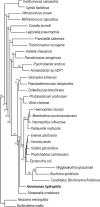Genome sequence of Aeromonas hydrophila ATCC 7966T: jack of all trades
- PMID: 16980456
- PMCID: PMC1698176
- DOI: 10.1128/JB.00621-06
Genome sequence of Aeromonas hydrophila ATCC 7966T: jack of all trades
Abstract
The complete genome of Aeromonas hydrophila ATCC 7966(T) was sequenced. Aeromonas, a ubiquitous waterborne bacterium, has been placed by the Environmental Protection Agency on the Contaminant Candidate List because of its potential to cause human disease. The 4.7-Mb genome of this emerging pathogen shows a physiologically adroit organism with broad metabolic capabilities and considerable virulence potential. A large array of virulence genes, including some identified in clinical isolates of Aeromonas spp. or Vibrio spp., may confer upon this organism the ability to infect a wide range of hosts. However, two recognized virulence markers, a type III secretion system and a lateral flagellum, that are reported in other A. hydrophila strains are not identified in the sequenced isolate, ATCC 7966(T). Given the ubiquity and free-living lifestyle of this organism, there is relatively little evidence of fluidity in terms of mobile elements in the genome of this particular strain. Notable aspects of the metabolic repertoire of A. hydrophila include dissimilatory sulfate reduction and resistance mechanisms (such as thiopurine reductase, arsenate reductase, and phosphonate degradation enzymes) against toxic compounds encountered in polluted waters. These enzymes may have bioremediative as well as industrial potential. Thus, the A. hydrophila genome sequence provides valuable insights into its ability to flourish in both aquatic and host environments.
Figures



References
-
- Abuhammour, W., R. A. Hasan, and D. Rogers. 2006. Necrotizing fasciitis caused by Aeromonas hydrophila in an immunocompetent child. Pediatr. Emerg. Care 22:48-51. - PubMed
-
- Albert, M. J., M. Ansaruzzaman, K. A. Talukder, A. K. Chopra, I. Kuhn, M. Rahman, A. S. Faruque, M. S. Islam, R. B. Sack, and R. Mollby. 2000. Prevalence of enterotoxin genes in Aeromonas spp. isolated from children with diarrhea, healthy controls, and the environment. J. Clin. Microbiol. 38:3785-3790. - PMC - PubMed
-
- Austin, B., and C. Adams. 1996. Fish pathogens, p. 197-244. In B. Austin, M. Altwegg, P. J. Gosling, and S. W. Joseph (ed.), The genus Aeromonas, 1st ed. John Wiley & Sons, Ltd., Chichester, United Kingdom.
Publication types
MeSH terms
Substances
Associated data
LinkOut - more resources
Full Text Sources
Other Literature Sources
Molecular Biology Databases
Miscellaneous

